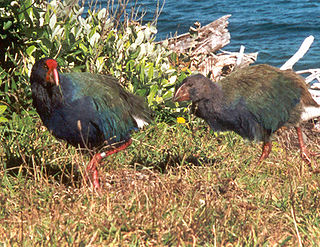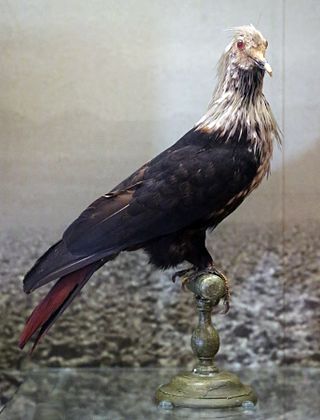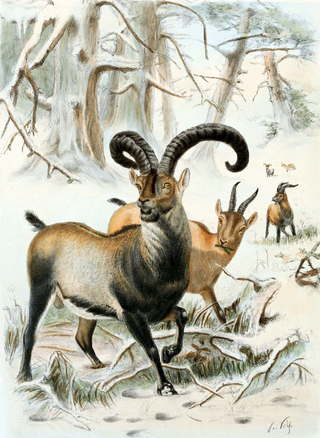Episodes
This article is missing information about episodes.(August 2019) |
| Lost Animals of the 20th Century | |
|---|---|
| Narrated by |
|
| No. of episodes | 16 |
| Original release | |
| Network | Discovery Channel |
Lost Animals of the 20th Century is a 16-episode documentary series shown on the Discovery Channel in the 1990s. It features animals that have become extinct throughout the 20th century. Animals are adjudged as such when the last specimen of the species dies sometime from 1900 to 1999. However, since the show was produced in the 1990s (still part of the 20th century), most of the animals covered became extinct in the early part of the century. Greta Scacchi introduces each episode during the title sequence and narrates episodes 1 through 8. Lin Sagovsky narrates the remainder of the series.
Each show is 30 minutes long and discusses five to six extinct species bound by a common theme (e.g. animals that became extinct for being too charismatic; animals that became extinct due to natural disasters). For each animal, a detailed sketch is shown, including the year when the last specimen died. The general characteristics, territorial habitat and location are discussed. For each animal, the feature ends with how they became endangered, and eventually extinct, including how and when the last specimen died. Often, live materials such as old films are included. In cases where such is unavailable, the live materials feature existing species that share the closest characteristics with the extinct animal.
Although the show specifically deals with animals that have become extinct, there was one episode that featured the theme of animals which were thought to be extinct, but have been rediscovered. Such has also been the case of some previously featured animals in the show, as scientists have eventually rediscovered extant populations or are attempting to revive species through selective breeding/cloning.
This article is missing information about episodes.(August 2019) |

The dodo is an extinct flightless bird that was endemic to the island of Mauritius, which is east of Madagascar in the Indian Ocean. The dodo's closest relative was the also-extinct and flightless Rodrigues solitaire. The two formed the subfamily Raphinae, a clade of extinct flightless birds that were a part of the family which includes pigeons and doves. The closest living relative of the dodo is the Nicobar pigeon. A white dodo was once thought to have existed on the nearby island of Réunion, but it is now believed that this assumption was merely confusion based on the also-extinct Réunion ibis and paintings of white dodos.

The thylacine, also commonly known as the Tasmanian tiger or Tasmanian wolf, is an extinct carnivorous marsupial that was native to the Australian mainland and the islands of Tasmania and New Guinea. The thylacine died out in New Guinea and mainland Australia around 3,600–3,200 years ago, prior to the arrival of Europeans, possibly because of the introduction of the dingo, whose earliest record dates to around the same time, but which never reached Tasmania. Prior to European settlement, around 5,000 remained in the wild on Tasmania. Beginning in the nineteenth century, they were perceived as a threat to the livestock of farmers and bounty hunting was introduced. The last known of its species died in 1936 at Hobart Zoo in Tasmania. The thylacine is widespread in popular culture and is a cultural icon in Australia.

The Réunion ibis or Réunion sacred ibis is an extinct species of ibis that was endemic to the volcanic island of Réunion in the Indian Ocean. The first subfossil remains were found in 1974, and the ibis was first scientifically described in 1987. Its closest relatives are the Malagasy sacred ibis, the African sacred ibis, and the straw-necked ibis. Travellers' accounts from the 17th and 18th centuries described a white bird on Réunion that flew with difficulty and preferred solitude, which was subsequently referred to as the "Réunion solitaire".

In paleontology, a Lazarus taxon is a taxon that disappears for one or more periods from the fossil record, only to appear again later. Likewise in conservation biology and ecology, it can refer to species or populations that were thought to be extinct, and are rediscovered. The term Lazarus taxon was coined by Karl W. Flessa and David Jablonski in 1983 and was then expanded by Jablonski in 1986. Paul Wignall and Michael Benton defined Lazarus taxa as, "At times of biotic crisis many taxa go extinct, but others only temporarily disappeared from the fossil record, often for intervals measured in millions of years, before reappearing unchanged". Earlier work also supports the concept though without using the name Lazarus taxon, like work by Christopher R. C. Paul.

Walking with Dinosaurs is a 1999 six-part nature documentary television miniseries created by Tim Haines and produced by the BBC Studios Science Unit, the Discovery Channel and BBC Worldwide, in association with TV Asahi, ProSieben and France 3. Envisioned as the first "Natural History of Dinosaurs", Walking with Dinosaurs depicts dinosaurs and other Mesozoic animals as living animals in the style of a traditional nature documentary. The series first aired on the BBC in the United Kingdom in 1999 with narration by Kenneth Branagh. The series was subsequently aired in North America on the Discovery Channel in 2000, with Avery Brooks replacing Branagh.

Edaphosaurus is a genus of extinct edaphosaurid synapsids that lived in what is now North America and Europe around 303.4 to 272.5 million years ago, during the Late Carboniferous to Early Permian. American paleontologist Edward Drinker Cope first described Edaphosaurus in 1882, naming it for the "dental pavement" on both the upper and lower jaws, from the Greek edaphos έδαφος and σαῦρος ("lizard").

The Popeye Show is an American cartoon anthology series that premiered on October 29, 2001, on Cartoon Network. Each episode includes three Popeye theatrical shorts from Fleischer Studios and/or Famous Studios. The show is narrated by Bill Murray, who gives the audience short facts about the history of the cartoons as filler material between each short. Animation historian Jerry Beck served as a consultant and Barry Mills served as writer and producer. A total of 45 episodes were produced, consisting of a total of 135 shorts.

The Mauritius blue pigeon is an extinct species of blue pigeon formerly endemic to the Mascarene island of Mauritius in the Indian Ocean east of Madagascar. It has two extinct relatives from the Mascarenes and three extant ones from other islands. It is the type species of the genus of blue pigeons, Alectroenas. It had white hackles around the head, neck and breast and blue plumage on the body, and it was red on the tail and the bare parts of the head. These colours were thought similar to those of the Dutch flag, a resemblance reflected in its French common name, Pigeon Hollandais. The juveniles may have been partially green. It was 30 cm (12 in) long and larger and more robust than any other blue pigeon species. It fed on fruits, nuts, and molluscs, and was once widespread in the forests of Mauritius.

Prehistoric Park is a six-part nature docu-fiction television programme that premiered on ITV on 22 July 2006 and on Animal Planet on 29 October 2006. The programme was produced by Impossible Pictures, who also created Walking with Dinosaurs. Each episode is an hour long including commercial breaks. Repeats of the show are broadcast in the UK on Watch.

Paludirex is an extinct genus of mekosuchine crocodylian from the Pliocene and Pleistocene of Australia. A large and robust semi-aquatic ambush hunter capable of attaining lengths of up to 5 m (16 ft), it was likely the top predator of Australia's waterways prior to the appearance of modern saltwater crocodiles. Two species are known, the smaller Paludirex gracilis and the larger Paludirex vincenti. A third as of yet unnamed species may have also existed.

The Roy Rogers Show is an American Western television series starring Roy Rogers. 100 episodes were broadcast on NBC for six seasons between December 30, 1951, and June 9, 1957. The episodes were set in the prevailing times (1950s) in the style of a neo-Western, rather than the Old West. Various episodes are known to be in the public domain today, being featured in low-budget cable television channels and home video.
Extinct was a Channel 4 TV series, that originally aired between 25 September to 30 October 2001. There were 6 episodes.

The sumxu, Chinese lop-eared cat, drop-eared cat, droop-eared cat, or hanging-ear cat, all names referring to its characteristic feature of pendulous ears, was a possibly mythical, long-haired, lop-eared type of cat or cat-like creature, now considered extinct, if it ever actually existed. The descriptions are based on reports from travellers, on a live specimen reportedly taken to Hamburg by a sailor, and on a taxidermy specimen exhibited in Germany. The cats were supposedly valued as pets, but was also described as a food animal. The last reported Chinese lop-eared cat was in 1938. It is believed by some to have been a mutation similar to that found in the Scottish Fold. The name sumxu originally described the yellow-throated marten, but a series of mistranslations caused the name to be applied to the alleged cat or cat-like animal.

The woolly mammoth is an extinct species of mammoth that lived during the Pleistocene until its extinction in the Holocene epoch. It was one of the last in a line of mammoth species, beginning with the African Mammuthus subplanifrons in the early Pliocene. The woolly mammoth began to diverge from the steppe mammoth about 800,000 years ago in Northeast Siberia. Its closest extant relative is the Asian elephant. The Columbian mammoth lived alongside the woolly mammoth in North America, and DNA studies show that the two hybridised with each other.

Crocodylus checchiai is an extinct species of crocodile from the Miocene to Pliocene of Libya and Kenya. C. checchiai was named in 1947 based on a skull from the Sahabi Formation. Remains from the lower Nawata Formation in the Turkana Basin of Kenya that were first attributed to the Nile crocodile have now been reassigned to C. checchiai, extending its geographic range. The morphology of the species, in particular the pronounced rostral boss, indicates that it may be the connecting link between African and American species of the genus Crocodylus.

De-extinction is the process of generating an organism that either resembles or is an extinct species. There are several ways to carry out the process of de-extinction. Cloning is the most widely proposed method, although genome editing and selective breeding have also been considered. Similar techniques have been applied to certain endangered species, in hopes to boost their genetic diversity. The only method of the three that would provide an animal with the same genetic identity is cloning. There are benefits and drawbacks to the process of de-extinction ranging from technological advancements to ethical issues.
Planet Earth is a television and film documentary franchise produced and broadcast by the BBC. The franchise began in 2001 with the success of The Blue Planet. As of 2017, The Blue Planet has spawned 5 series and one feature film.
Extinct or Alive is an American wildlife documentary television programme produced for Animal Planet by Hot Snakes Media of New York City, the United States. It is hosted by conservationist and television personality Forrest Galante, who travels to different locations around the globe to learn about possibly extinct animals and whether or not there is a chance that they may still be extant. The series has been involved in the possible rediscovery of eleven animals, namely the Zanzibar leopard, the Pondicherry shark, the Fernandina Island Galápagos tortoise, the Miller's grizzled langur, the Cape lion, the Malagasy hippopotamus, the Yangtze giant softshell turtle, Rio Apaporis caiman, Whitetip weasel shark, Ornate sleeper-ray and the Flapnose houndshark.

IberospinusIPA:[aɪbiːʌroʊs̠piːnʊs̠] or IPA:[aɪbiːʌroʊs̠paɪnʌs̠] is an extinct genus of spinosaurid dinosaur from the Early Cretaceous (Barremian) Papo Seco Formation of Portugal. The genus contains a single species, I. natarioi, known from several assorted bones belonging to one individual. Iberospinus represents one of four known spinosaurid taxa from the Iberian Peninsula, the others being Vallibonavenatrix, Camarillasaurus and Protathlitis. It is important for its implications of the geographical origin of Spinosauridae and the suggested presence of an at least semi-aquatic lifestyle early in the evolution of this clade.